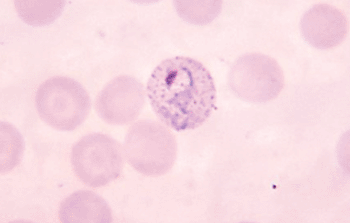Platelet Indices Altered in Severe Malaria
By LabMedica International staff writers
Posted on 08 Jan 2014
Changes in platelet counts during acute malaria are common and such changes are a major cause of concern to clinicians because such cases are more likely to evolve into serious and complicated disease. Posted on 08 Jan 2014
The reduction in the number of platelets, platelet function is also compromised in these patients suffering from acute malaria infection and this is generally evidenced by changes in the volume and other features of platelet cells.

Image: Photomicrograph shows a growing Plasmodium vivax trophozoite in a blood smear (Photo courtesy of the CDC - US Centers for Disease Control and Prevention).
Scientists at the University Hospital of Federal University of Mato Grosso (Cuiabá, Brazil) performed a cross-sectional descriptive study based on the clinical and laboratory data of 186 patients with acute malaria caused by Plasmodium vivax who attended the Malaria Clinic between 2008 and 2013. All the patients underwent hemogram and blood biochemical analyses at their first appointment and malaria was diagnosed on the basis of the microscopic examination of Giemsa-stained thick smears.
All blood cell counts were determined using the Pentra 80 automated equipment (Horiba Medical; Montpellier, France), which provides results for mean platelet volume (MPV), platelet distribution width (PDW), and plateletcrit (PCT). The normal ranges for MPV, PDW, and PCT provided for this equipment are 7.0/µm3–10.5/µm3, 11%–18%, and 0.15%–0.50% respectively. Patients with a longer duration of symptoms or those identified as primo infected were considered potential candidates for evolution into the severe form of malaria.
The MPV, PDW, and PCT values exhibited significant variability. A significant inverse relationship was observed between parasitaemia and PCT. Patients with warning signs for evolution into severe disease, with primo infection, or presenting with symptoms for over three days had the highest MPV and PDW. The mean platelet count was 114,823 ± 76,761 cells/mm3; 16.7% of the patients exhibited counts fewer than 50,000/mm3 and 60.7% had platelet counts between 50,000/mm3 and 150,000/mm3. The mean MPV was 9.3 µm, the mean PDW was 17.5% and mean PCT was 0.104%. Potentially more serious cases, that is, primo-infected patients, exhibited significantly higher MPV and PDW.
The authors concluded that that platelet indices were altered during acute and symptomatic infection by P. vivax. The elevation of MPV and PDW, and reduction of PCT are related to known potential risk factors for evolution into severe malaria, such as primo infection, longer symptom duration, and the presence of the classical warning signs of severe and complicated P. falciparum malaria. Therefore, these parameters and indices could be useful as predictors of severity in the clinical approach of patients with malaria caused by P. vivax. The study was published on December 27, 2013, in the Malaria Journal.
Related Links:
University Hospital of Federal University of Mato Grosso
Horiba Medical














